https://news.google.com/__i/rss/rd/articles/CBMiWmh0dHBzOi8vd3d3LmNubi5jb20vMjAxOS8xMi8zMS90ZWNoL3NwYWNleC1jcmV3LWRyYWdvbi1lbG9uLW11c2stdmlkZW8tdHJuZC1zY24vaW5kZXguaHRtbNIBAA?oc=5
2019-12-31 15:35:00Z
52780527899747
[unable to retrieve full-text content]
The 100 Best Science Photos of 2019 Livescience.com
For almost 350 years, physicists have been trying to decode Newton’s three-body problem - the problem of figuring out how three similar objects or bodies are going to travel in space in a way that fits in with the laws of motion and gravity. The three laws of motion laid down by Isaac Newton in 1687 are these: objects remain in a state of inertia unless acted upon by force, that the relationship between acceleration and applied force is force equals mass times acceleration (F=ma), and that for every action there is an equal and opposite reaction.
SEE ALSO: Newton’s Law Of Gravity Was Wrong, Claim Scientists; Target Einstein’s ‘General Relativity’ Next
So far, Newton’s basic physics of the universe could be explained. But when the same rules were applied to the Moon, Earth and the Sun, Newton ran into difficulty as it became much harder to track these three original bodies with these mathematical rules. However now, scientists have found fixes for special cases. They’ve found the general formula to be elusive and developed a statistical formula that fits the infamous the ‘oldest open question in astrophysics’ in certain scenarios.
While the researchers point out that they have not come up with an exact, complete solution for the three-body problem, they have cracked a statistical method that covers a lot of these three-body to two-body events, one which can be very useful in helping physicists visualise complicated processes. They looked up a couple of centuries of previous research that puts forward the following idea: in unstable, chaotic three-body systems, one of those bodies eventually gets expelled, leaving behind a stable binary relationship between the remaining two.
SEE ALSO: Apparently, Newton Was An Alchemist And Scientists Just Discovered One Of His Lost Recipes
As per the study, the researchers applied a probability hypothesis called ergodicity to help guide them to their answers, which uses the principle of averages to work out what's going to happen in a particular system. Importantly, over time, ergodic processes bear little relation to their original state (just like a three-body system). What the new solution does is give scientists an understanding of how the two survivors of a three-body problem are going to behave in a variety of newly stable scenarios. That sort of understanding can be crucial in astrophysics.
Astrophysicist at the Hebrew University of Jerusalem Nicholas Stone reportedly explains, “Take three black holes that are orbiting one another," says Stone. "Their orbits will necessarily become unstable and even after one of them gets kicked out, we're still very interested in the relationship between the surviving black holes."
SEE ALSO: 100 Years Of Einstein’s General Relativity Theory: How It Became The Best Theory Of Gravitation
Cover Credit: Dhawal Bhanushali/ Mashable India
[unable to retrieve full-text content]
The 12 Most Important and Stunning Quantum Experiments of 2019 Livescience.com[unable to retrieve full-text content]
10 Things We Learned About Humans in 2019 Livescience.comNASA engineers witnessed their newest Mars rover take its first steps in preparation for its next mission that will search for fossilized remains of ancient life on the red planet.
The test took place inside the Spacecraft Assembly Facility clean room at NASA’s Jet Propulsion Laboratory in Pasadena, California. Engineers clad in white bunny suits—special cleanroom attire worn in order to keep the rover’s delicate instruments very, very clean—watched the yet-to-be-named rover inch forward as part of the crucial pre-flight test, which lasted just over 10-hours.
“Mars 2020 has earned its driver’s license,” Rich Rieber, the lead mobility systems engineer for Mars 2020, said in a news release. “The test unambiguously proved that the rover can operate under its own weight and demonstrated many of the autonomous-navigation functions for the first time. This is a major milestone for Mars 2020.”
During the test, NASA engineers noticed no problems, as the six-wheeled rover successfully performed all its required tasks: it rolled forward and backward and even pirouetted. According to NASA, the rover’s systems, all working in concert, enabled it to steer, turn and drive with ease.
The testing of the vehicle’s autonomous navigation system went well. Since these systems performed perfectly under Earth’s gravity, engineers expect them to perform just as well under Mars’ gravity, which is only 38% of what we experience on Earth.
The test went so well that NASA says the “next time the Mars 2020 rover drives, it will be rolling over Martian soil.” The Mars 2020 rover is scheduled to launch in July 2020, followed by a landing in Jezero Crater on February 18, 2021.
“A rover needs to rove, and Mars 2020 did that,” John McNamee, project manager for Mars 2020, said in a statement. “We can’t wait to put some red Martian dirt under its wheels.”
During its initial test drive, the rover crept forward in small, 3-feet ( 1-meter) increments, enabling the engineers to properly assess its movement and steering abilities. The rover also drove over small ramps designed to simulate uneven Martian terrain.
Engineers were also able to collect data from the vehicle’s Radar Imager for Mars’ Subsurface Experiment (RIMFAX)—an instrument that uses radar waves to scan the ground below the rover. Depending on the terrain, once on Mars, RIMFAX will penetrate the ground, probing the red planet’s subsurface to depths of more than 30-feet (or 10-meters).
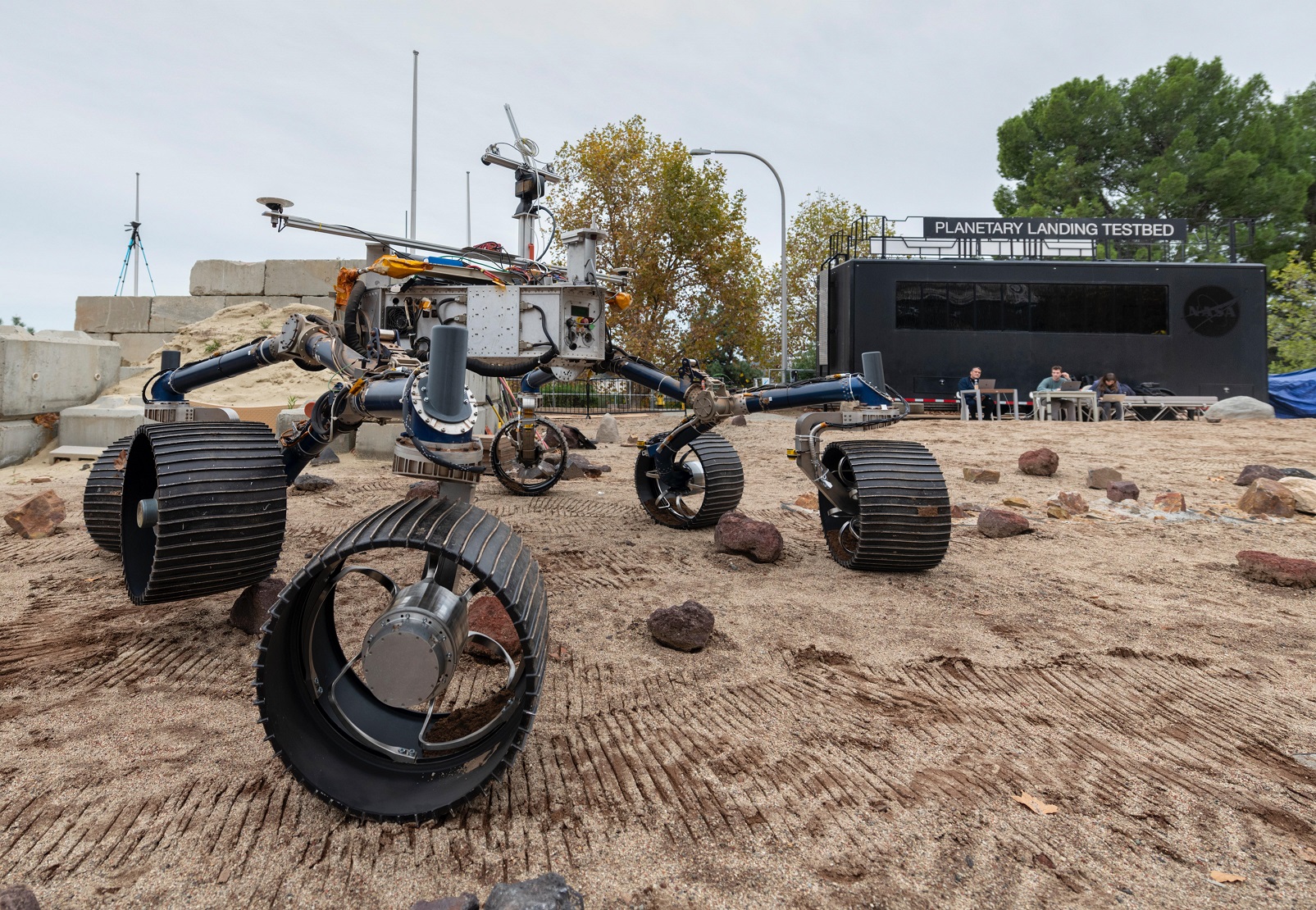
Curiosity, the Mars 2020 rover’s predecessor currently roaming around on Mars, is predominantly commanded by people back on Earth. However, the rover does have the ability to autonomously choose where to fire its laser spectrometer. As part of its onboard science arsenal, the instrument—called ChemCam—is designed to analyze the chemical composition of nearby rocks and soil.
Mars 2020, on the other hand, will be more independent than any of its predecessors. Equipped with advanced auto-navigation software, the rover will drive with the help of a dedicated onboard computer operating on data collected from the vehicle’s high-resolution, wide-field color cameras.
NASA engineers estimate that the rover will travel an average of 650 feet (200 meters) per day. For comparison, Curiosity’s current distance record for a single day is 702 feet (214 meters), although that’s not typical. The Mars 2020 rover will also be sporting more durable wheels. Curiosity’s wheels are visibly worn after seven years on the Martian surface; engineers hope Mars 2020’s wheels will hold up better.
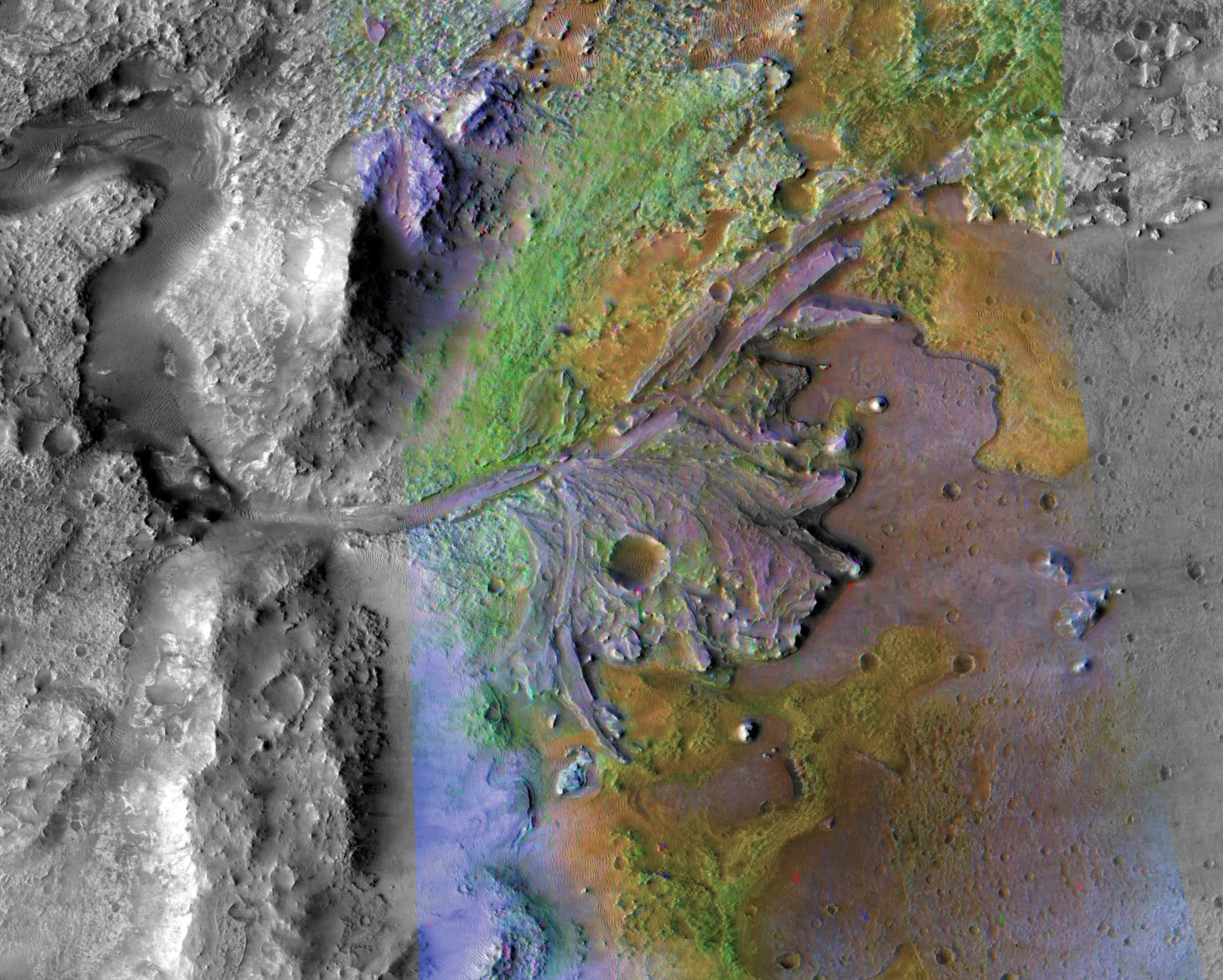
Once on Mars, the rover will land at Jezero Crater—a former lake bed, rich in mineral deposits known for preserving microfossils here on Earth. In this crater, the rover will search for any signs that life may have once existed on Mars.
While acting as a remote scientist, the rover will unlock clues about the planet’s climate and geology as well as collect samples that will be returned to Earth sometime in the future.
Following the loss of the Opportunity rover, Curiosity has been the sole robot roaming the Martian surface. That will change in 2021, but they won’t be the only ones.
They will be joined by another: The European Space Agency is teaming up with Russia to send their version of the Mars 2020 rover. The Rosalind Franklin ExoMars rover will arrive on Mars at a soon-to-be-announced location, in 2021.

[unable to retrieve full-text content]
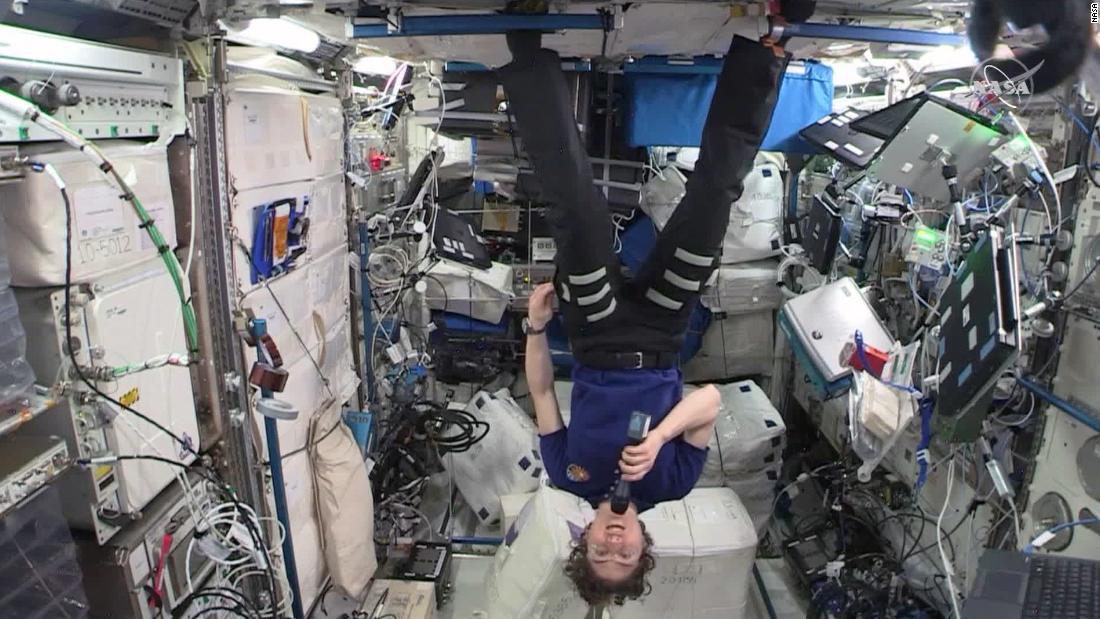
[unable to retrieve full-text content]
Elon Musk Expects Starship Flight Hopefully in Two-Three Months Bloomberg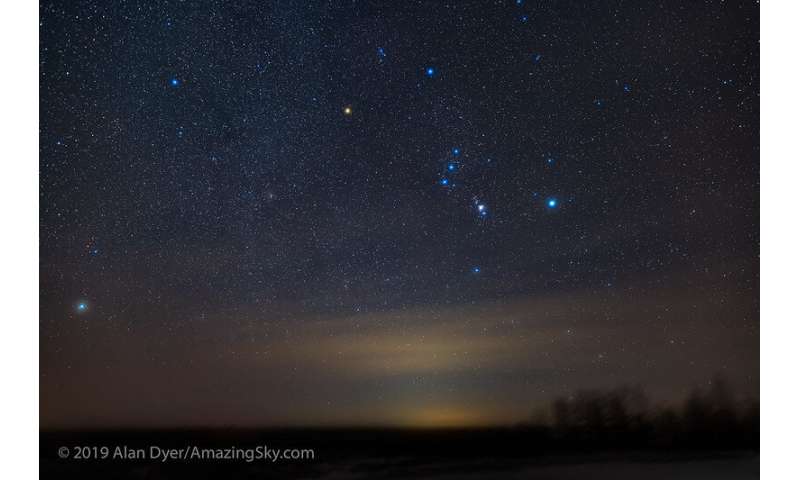
Have you noticed that Orion the Hunter—one of the most iconic and familiar of the wintertime constellations—is looking a little… different as of late? The culprit is its upper shoulder star Alpha Orionis, aka Betelgeuse, which is looking markedly faint, the faintest it has been for the 21st century.
When will this nearby supernova candidate pop, and what would look like if it did?
The story starts, as all good astronomy and space stories seem to, on Friday night going into a holiday weekend. We started seeing discussion on Betelgeuse trending on social media on the evening of Friday, December 20th, and dug down to the source of the excitement: a December 8th paper, "The Fainting of the Nearby Red Supergiant Betelgeuse," by researchers at Villanova University. Light curve estimates courtesy of the American Association of Variable Star Observers (AAVSO) verified the assertion that the star had, indeed, faded about one magnitude, or a little over one-half from its usual magnitude +0.5 to +1.5. Noticing the sky was clear, we headed up to our parking garage rooftop observing site in downtown Norfolk, Virginia, to take a look. Betelgeuse was, indeed, noticeably fainter, about a shade dimmer than nearby +1 magnitude Aldebaran.
Now, a change in one magnitude isn't unusual for a variable star such as Betelgeuse. But such a large dip always gives the astronomical community pause. A red giant star 12 times as massive as the sun and about 700 light years distant, the variability of red-orange Betelgeuse was first noted by astronomer Sir John Herschel in 1836. Physically, the star is currently bloated out to a radius of perhaps eight astronomical units (AU). If you plopped it down in the center of our solar system, Betelgeuse might extend all the way out past the orbit of Jupiter.
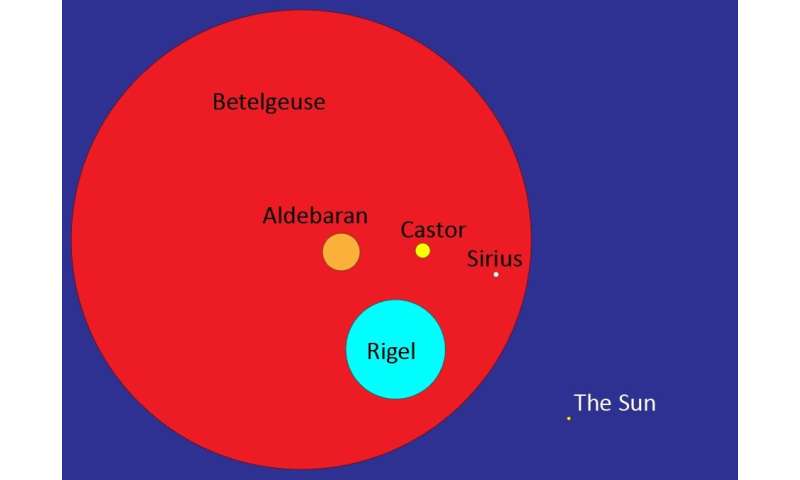
This fact also allowed astronomers to use the first crude optical interferometric measurements from the 2.5 meter telescope at Mount Wilson Observatory to measure Betelgeuse's physical diameter of 50 milliarcseconds. In the late 1980s, astronomers used an emerging technique of aperture masking interferometry to obtain the first direct 'image' of Betelgeuse.
Betelgeuse is always worth keeping an eye on, as it's one of the closest candidates in our galaxy for a nearby supernova. We see supernovae frequently in distant galaxies, but such an event has not been witnessed in our galaxy in the telescopic era: Kepler's Star in 1604 in the constellation Ophiuchus was the last supernova observed in the Milky Way, though a supernova in the nearby Large Magellanic Cloud put on a good show in 1987. A red giant like Betelgeuse lives fast and dies young, exhausting its supply of hydrogen fuel in just under 10 million years. The star is destined to undergo a core implosion and massive collapse and rebound as a Type II supernova. Such an explosion could occur 100,000 years from now… or tonight.
Is the fading act a prelude to a truly spectacular show, or a false alarm? Astronomers are unsure, but a supernova event just 700-odd light-years away would be an unrepresented opportunity to study one up close. Not only would every optical telescope get trained on the exploding star, but assets such as the Laser Interferometry Gravitational Wave Observatory (LIGO) could detect gravitational waves from a nearby supernova, and neutrino observatories such as Ice Cube buried in the Antarctic ice could detect the event, as well.

Fortunately for us, we're safely out of the 50 light-year 'kill zone' for receiving any inbound lethal radiation from Betelgeuse: A supernova would simply be a scientifically interesting event, and put on a good show. Ancient supernovae may have had a hand in the evolution of life on Earth, and a recent study suggests that one might even have forced early humans to walk upright.
What would a supernova in Orion look like? Well, using the last supernova in the Large Magellanic Cloud (also a Type IIb event) as a guide, we calculate that when it does blow, Betelgeuse would shine at magnitude -10. That's 16 times fainter than a full moon, but 100 times brighter than Venus, making it easily visible in the daytime sky. A Betelgeuse-gone-supernova would also easily cast noticeable nighttime shadows.
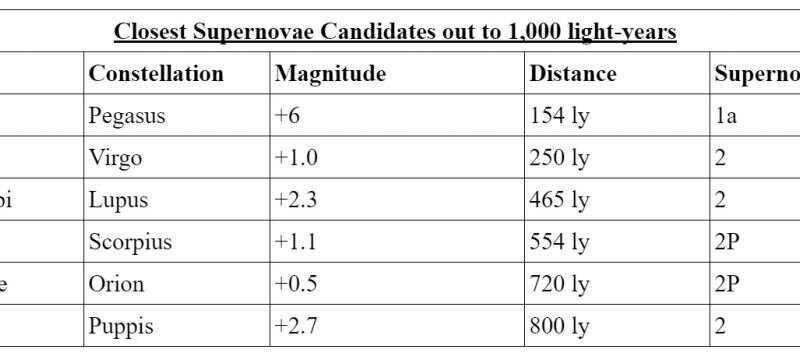
But see the ongoing fading event for yourself. Betelgeuse is easy to find in December, rising to the east at dusk. In fact, northern hemisphere winter is the very best time for the star to blow, as it's roughly opposite to the sun, and would dominate the night sky. Summer would be the worst time, as it would tease us from beyond the far side with the sun in the daytime sky.
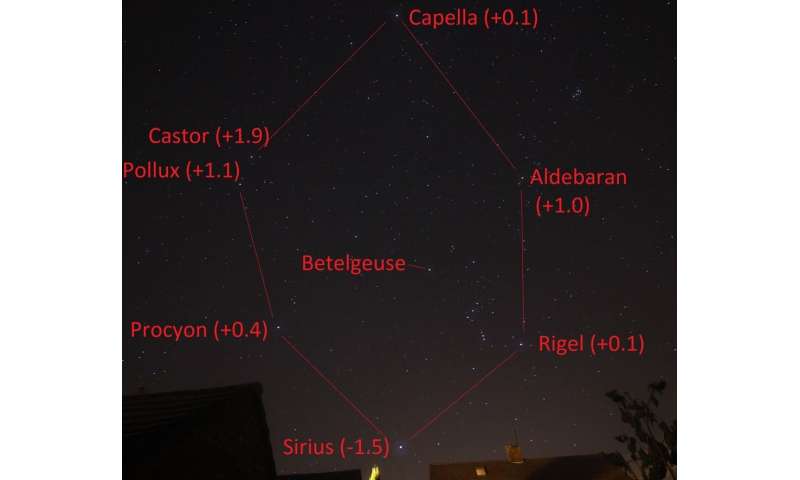
What's next? Well, expect Betelgeuse to brighten again in early 2020… though if it rebounds into negative magnitude territory past Rigel and Sirius, well, then things could get really exciting.
For now though, we're in a wait-and-see-mode for any New Year's Eve fireworks from Betelgeuse. Such an occurrence would be bittersweet: We would be extraordinarily lucky to see Betelgeuse go supernova in our lifetime… but familiar Orion the Hunter would never look the same again.
Explore further
Citation: Waiting for Betelgeuse: what's up with the tempestuous star? (2019, December 27) retrieved 27 December 2019 from https://phys.org/news/2019-12-betelgeuse-tempestuous-star.html
This document is subject to copyright. Apart from any fair dealing for the purpose of private study or research, no part may be reproduced without the written permission. The content is provided for information purposes only.
[unable to retrieve full-text content]
In what will prove to be its most critical flight to date, China’s Chang Zheng 5 (or Long March 5, as it is known outside of China) rocket is ready for its third mission after two less-than-perfect previous flights.
A successful flight today would pave the way for three critical launches in 2020: a lunar flight, a Mars mission, and a human spacecraft test flight.
If all goes to plan, the Chang Zheng 5 will liftoff from the Wenchang Spacecraft Launch Site in Hainan, People’s Republic of China at 07:45 EST (12:45 UTC) on Friday, 27 December 2019 with the Shijian-20 test satellite bound for Geostationary Orbit.
Chang Zheng 5 rocket overview:
The Chang Zheng 5 is China’s heavy lift rocket – comparable in lift capacity to the Ariane 5, Delta IV Heavy, Falcon 9 and Proton-M rockets.
It has a single launch site at the Wenchang Spacecraft Launch Site in southern China.
The Chang Zheng 5 can take the following payload masses to the following destinations:
| Destination | Mass |
| Low Earth Orbit (200 x 400 km orbit inclined 42°) | 25,000 kg (55,115 lb) |
| Geostationary Transfer Orbit (GTO) | 14,000 kg (30,864 lb) |
| Trans-Lunar Injection (TLI) | 8,200 kg (18,077 lb) |
Its first stage core is augmented by four strap-on liquid fueled boosters that together produce 10,631 kN (~2,390,000 lbf) of thrust at liftoff, increasing to a maximum of 12,054 kN (~2,710,000 lbf) thrust as the rocket ascends into vacuum.
Each of the four strap-on boosters contain two YF-100 engines and fire for 180 seconds.
The YF-100 engines burn RP-1 rocket-grade kerosene and liquid oxygen.

The mission patch of Shijian-20. (Credit: China Aerospace Science and Technology Corporation)
The core stage uses two upgraded YF-77 engines burning liquid hydrogen and liquid oxygen. Total stage burn time is 480 seconds (8 minutes).
The YF-77 engines were found to be faulty and not as reliable as hoped and were the direct cause of the Chang Zheng 5’s 2017 launch failure on its second mission.
The rocket’s second stage likewise burns liquid hydrogen and liquid oxygen for its two YF-75D engines – which produce a total of 176.52 kN (39,680 lbf) thrust for 700 seconds (11 minutes 40 seconds).
The rocket can fly with or without a third stage. To date, both flown missions – as well as today’s third flight – have all used a third stage.
The optional third stage uses two YF-50D engines burning nitrogen tetroxide and unsymmetrical dimethylhydrazine for up to 1,105 seconds (18 minutes 25 seconds) of powered flight.
The first two stages of flight accidentally inserted the third stage and payload into the incorrect orbit. The third stage was able to compensate and take the payload into the correct orbit for deployment and operation.
The first flight was deemed a success.
The issue resulted in a shallower flight profile than intended and the complete loss of the mission.
After the failure, the China Aerospace Science and Technology Corporation redesigned the first stage and the YF-77 engine.
Those changes have been heavily tested.
The Shijian-20 payload, Chang Zheng 5’s Return To Flight mission:
While arguably the most important aspect of this mission will be to demonstrate the Chang Zheng 5’s ability to successfully Return To Flight, the mission will carry a payload.
Riding atop the Chang Zheng 5’s third stage will be the Shijian-20 test satellite.
In Mandarin, “Shijian” means “Practice”. To this end, Shijian-20 is a Chinese telecommunications satellite designed in part to test or practice new technology for follow-on missions.
The Shijian-20 satellite will be the maiden flight of the DFH-5 ultra-high-performance satellite platform featuring a high-thrust ion propulsion system with up to 28 Kilowatts power.
The satellite will have 70 Gbps of high-throughput communications capability in the Ka-band.
In everyday use on Earth, the Ka-band frequency range is most commonly used for 5G mobile telecommunication networks.
The Shijian-20 satellite also carries an optical infrared laser communications terminal for downlink data rates of up to 4.8 Gbps.
ℹ:https://t.co/wjgD3gZdi1 pic.twitter.com/1DNLzD2d3Q
— LaunchStuff (@LaunchStuff) December 26, 2019
Moreover, the satellite has an experimental quantum communications payload.
But the most important part of this mission, unusually, is not the payload but rather proving the rocket’s ability in flight.
After a hiccup on the first flight and the outright failure of the rocket on its second mission, this third flight carries weighted importance due to the Chang Zheng 5’s schedule for 2020.
Next year, China plans to use the rocket for three immensely important flights:
Beginning in 2021, the rocket will also be called upon to launch China’s multi-module space station.
For its 2020 schedule, the crew spacecraft test and lunar sample return missions can adjust their launch dates, but the Mars mission must meet a strict 20-ish day interplanetary launch window or stand down for 26 months until the window between Earth and Mars opens again.
Any issue with the Chang Zheng 5’s Return To Flight today would call into question its ability to meet the 2020 Earth-Mars launch timeline and would be a blow to China’s rapid-pace spaceflight industry.
Wenchang launch site:
In what will be the 103rd and final orbital launch attempt of 2019, the China Aerospace Science and Technology Corporation will launch the Chang Zheng 5 rocket from LC-1 at the Wenchang Spacecraft Launch Site on the island province of Hainan.

The Chang Zheng 5/Long March 5 heavy-lift rocket rolls out to its launch pad at Wenchang. (Credit: Getty Images)
The Wenchang Spacecraft Launch Site is part of the Xichang Satellite Launch Center and is not an independently administered launch site.
Located on the northeastern part of the island, the Wenchang Spacecraft Launch Site was chosen for its proximity to the equator – allowing for greater payload launch mass – as well as its location next to the open waters of the Pacific Ocean which allows for launches to take place over the sea instead of land.
Located at 19° 36′ 52.17″ N latitude, it is China’s southernmost launch site.
A former suborbital launch test location, Wenchang was converted for orbital launch operations beginning October 2007. Construction of the site was completed October 2014, and its first orbital launch took place 25 June 2016 with a Chang Zheng 7 rocket from LC-2.
Not counting today’s scheduled mission, Wenchang has hosted four launches: two Chang Zheng 5 and two Chang Zheng 7 rockets.
Unfortunately, our website is currently unavailable in most European countries. We are engaged on the issue and committed to looking at options that support our full range of digital offerings to the EU market. We continue to identify technical compliance solutions that will provide all readers with our award-winning journalism.

On Earth and in space, NASA had a busy decade in the 2010s.
In its human spaceflight program, the agency retired the space shuttle and is now close to launching humans to space again, this time on commercial crew vehicles. NASA also changed its long-term destination for humans a few times; currently the agency is targeting the moon and Mars.
Meanwhile, NASA robots flew through interstellar space, imaged thousands of planets and sent reams of scientific data back to researchers. Here are some of the agency's milestones over the last 10 years.
The decade started with turmoil for NASA's human spaceflight program when President Barack Obama's administration canceled the plans from President W. George Bush's administration to bring astronauts to the moon under the Constellation program. (In 2009, a NASA advisory commission that had gathered to evaluate Constellation noted that the then-5-year-old program was over cost and behind schedule.)
Also in this year, the space shuttle program began its last full year of operations, focusing on large payloads such as the cupola, a large window for Earth observations. NASA requested one last extra shuttle flight, which was approved in 2011.
Meanwhile, the Deep Impact spacecraft flew by Comet Hartley, becoming the first spacecraft to visit two comets. The Spirit rover on Mars fell silent about six years past its initial 90-day expiration date. The scientists behind the orbital Mars Odyssey mission released a global map of the Red Planet based on eight years of data from the spacecraft, which is still operating today.
The shuttle program made its final bow this year carrying cargo to the International Space Station. One of the last shuttle flights delivered a $2 billion astrophysics experiment called the Alpha Magnetic Spectrometer in May. (Astronauts have been conducting spacewalks in 2019 to repair that instrument, which studies dark matter.) Finally, in July, the space shuttle made its last flight, wrapping up 30 years of operations and 131 flights (including two fatal accidents, in 1986 and 2003).
From then on, NASA astronauts would fly to space aboard Russian Soyuz capsules; discussions about how many seats to buy, and how often, would dominate much of the 2010s. The Obama administration chose to retain the planned Orion spacecraft, originally envisioned for the now-defunct Constellation program, recruiting it for other planned deep-space missions, including to an asteroid around 2025 and Mars in the 2030s.
Meanwhile, because of the soaring cost and numerous launch delays of the James Webb Space Telescope, which was then slated to launch in 2018, NASA said that the instrument would need to pull money from other planned science missions. But the ongoing NASA/European Hubble Space Telescope mission discovered a previously unknown moon around Pluto, Kerberos. (When the same instrument found a second, Styx, in 2012, NASA personnel began to worry that these moons meant the New Horizons probe might run into unexpected debris during its flyby of the dwarf planet in 2015.)
NASA also braved the inner solar system, as the Messenger spacecraft successfully entered orbit around Mercury after a seven-year journey. In the other direction, the Juno spacecraft launched toward Jupiter on Aug. 5, 2011. In Earth orbit, NASA's Glory observatory failed to reach orbit during launch, in an issue eventually traced back to the instrument's aluminum manufacturer. NASA launched the National Polar-orbiting Operational Environmental Satellite System Preparatory Project (NPP) to examine Earth weather and climate.
The International Space Station entered a new era of cargo support when SpaceX's Dragon spacecraft made the first private flight to the space station. NASA began construction on the massive Space Launch System rocket to bring astronauts across the solar system. (That craft's first flight, originally expected in 2017, was delayed until at least 2021.
NASA survived 7 minutes of terror when the Curiosity rover safely landed on Mars in August, stepping up the agency's search for habitability on the Red Planet; within weeks of landing, the spacecraft had found an ancient streambed and evidence that water had flowed in the craft's landing area. Meanwhile, the Dawn probe bid goodbye to the large asteroid Vesta in September 2012, after characterizing the object's iron core and finding large craters on its surface.
At the space station, Italian astronaut Luca Parmitano (who will ring in the new year in space) nearly drowned during a spacewalk when a water leak in the cooling system filled his helmet with fluid. Parmitano made it safely back to the space station, and NASA soon redesigned spacewalk procedures to improve astronaut safety. NASA began to contemplate extending the space station's tenure beyond its believed expiration date of 2020.
At Mars, damaged wheels on the Curiosity rover forced NASA to seek smoother terrain. The NASA/European Solar and Heliospheric Observatory mission watched Comet ISON plunge into the sun over Thanksgiving, belying predictions that the comet could be one of the brightest in recent memory.
So many gyroscopes failed on the Kepler space telescope, by now long past its prime planet-hunting mission, that NASA pioneered a new technique that used the pressure of the sun to hold the instrument stable. This allowed Kepler to continue work under an extended mission, known as K2.
In other mission milestones, the Mars Atmosphere and Volatile Evolution (MAVEN) spacecraft launched for the Red Planet on Nov. 18. Meanwhile, NASA announced an Asteroid Redirect Mission to snag a boulder off an asteroid in order to begin testing planetary defense techniques. And NASA launched a Landsat satellite, which continued an Earth-observation program that has been running since the early 1970s.
In September, NASA selected Boeing and SpaceX for multi-billion-dollar contracts to eventually bring astronauts to the International Space Station. Originally, those flights were scheduled to launch by 2017, but programmatic and technical delays have pushed back the first crewed launch to at least 2020. NASA successfully tested the deep-space Orion spacecraft; at the time, the agency thought a second uncrewed launch would follow in 2017; that flight is now scheduled for no earlier than 2020.
NASA extended the space station's scheduled mission to 2024. NASA and Russia's Roscosmos space agency quibbled over their shared human spaceflight plans when a senior Russian official sarcastically suggested that NASA send astronauts to space by trampoline. However, the partnership continued with no delays to human spaceflight.
On Mars, the Curiosity rover arrived at its ultimate destination, Mount Sharp, about two Earth years after landing; critics at NASA had said that controllers were taking too long to reach the destination as the rover sampled other scientific sites en route. Curiosity also spotted its first signs of methane on the Red Planet; in the coming years, the rover found other possible signs of life, including oxygen and organic molecules.
Meanwhile, the NASA/European Cassini mission found signs of 101 water geysers at the Saturn moon Enceladus. Scientists studying the activity wondered whether the plumes could represent the sort of activity that might power microbial life. MAVEN arrived at the Red Planet to study the loss of Martian atmosphere over time.
NASA astronaut Scott Kelly and Russian cosmonaut Mikhail Kornienko began a nearly yearlong mission in space, the first such long-duration flight since the Mir space station missions of the 1990s. Two cargo ships in a row failed to reach the space station, sparking speculation about how long a crew could survive without more supplies, but a third flight arrived as expected.
Two mission arrivals made headlines. The New Horizons spacecraft flew by Pluto in July and revealed a surprisingly complex world of ancient lakes and large mountains, prompting more cries from the astronomical community to give Pluto its planethood status back. The Dawn spacecraft arrived at dwarf planet Ceres in March for several years of investigation, including figuring out the nature of mysterious bright spots visible en route. These turned out to be salts.
Meanwhile, the long-running NASA and European Solar and Heliospheric Observatory discovered its 3,000th comet. The Messenger spacecraft impacted Mercury on April 30, wrapping up a four-year orbital mission that imaged the entire surface of that planet for the first time. NASA received approval to launch a mission to Jupiter's moon Europa, later called Europa Clipper, which is scheduled to launch early next decade.
Astronauts began installing new docking ports for commercial crew vehicles to arrive at the International Space Station. Bigelow Aerospace launched an "inflatable room" to the space station for testing in April that was inflated in May and remains operational as of this writing. President Donald Trump was elected, and his first space priorities after assuming office in January 2017 included canceling the Obama administration's plans to send humans to visit an asteroid.
Meanwhile, on Mars, Curiosity's drill encountered problems that took about two years to address. NASA delayed the launch of the InSight mission to join Curiosity on the Red Planet after a seismometer vacuum leak forced engineers to pull the instrument for a fix. The agency toyed with the idea of canceling the mission, but a subsequent review identified InSight as a high priority for life-seeking missions, and it was rescheduled, launching in 2018.
The Juno spacecraft arrived at Jupiter on July 4, beginning its mission to study the atmosphere of the giant planet to gain more insight into the Jovian weather. NASA's Asteroid Redirect Mission passed a key design milestone.
NASA astronaut Peggy Whitson captured the U.S. record for most overall time in space, landing in September with a total tally of 665 days in orbit.
Meanwhile, the NASA/European Cassini spacecraft wrapped up 13 years of investigations at Saturn by conducting a "grand finale" series of sweeps through the planet's rings. Then, controllers deliberately threw the machine into the atmosphere of the planet, to protect icy, potentially habitable moons in the neighborhood from any possibility of contamination.
Two missions faced hurdles: NASA delayed the James Webb Space Telescope launch from 2018 to 2019; that schedule has now slipped even further, to 2021. President Trump's new administration filed a budget request aiming to cancel the planned Asteroid Redirect Mission, which was officially canceled in 2018.
The Trump administration released its first space policy directive in December, ordering NASA to fly astronauts to the moon in 2028. The plans rely on NASA's massive Space Launch System, which was the subject of a report on development and funding issues conducted by NASA's Office of Inspector General.
Two astronauts survived an aborted launch on a Soyuz rocket on Oct. 11. The International Space Station partners successfully adjusted the Expedition 58 launch date three weeks earlier to accommodate the missing crew rotation; a new launch went off without a hitch on Dec. 3.
Voyager 2, a spacecraft launched in 1977 to explore the outer planets, crossed out of the bubble surrounding our sun and into interstellar space, continuing to send back data about its environment.
Two venerable missions ended when they ran out of fuel: Dawn, which had been studying the dwarf planet Ceres, and the Kepler space telescope, which showed that exoplanets are common in our universe.
Three new missions joined the NASA roster. InSight finally launched to Mars in May and made a safe landing in November, accompanied by the first interplanetary cubesats. The Transiting Exoplanet Survey Satellite (TESS) launched to seek planets orbiting nearby, bright stars. The Parker Solar Probe launched in August to get the first close-up views of the sun.
Preparations for NASA's commercial crew program entered the final stretches, with both SpaceX's Crew Dragon and Boeing's Starliner launching their first test flights. NASA's Office of Inspector General, however, warned that ongoing delays in the program are expected to lead to smaller space station crews for at least the first half of 2020.
NASA is also working to send astronauts safely back to the moon in 2024, after Vice President Mike Pence announced a four-year acceleration of the previous deadline. However, critics say the new timeline might not be realistic. NASA also celebrated the 50th anniversary of the Apollo 11 moon landing on July 20, marking the occasion with numerous events.
In space, astronauts began tricky repairs on a dark-matter detector called the Alpha Magnetic Spectrometer. NASA classified the missions as the most difficult spacewalk work since the Hubble Space Telescope upgrade conducted in 2009. NASA astronauts also performed the first all-woman spacewalk, and the agency announced that crewmember Christina Koch would stay in space three extra months, putting her on track to make the second longest spaceflight in NASA history.
NASA and other government agencies began the year during what would become the longest-ever government shutdown, prompting agency concerns about the long-term effects on astronomy.
Also in January, the New Horizons spacecraft flew by Kuiper Belt asteroid 2014 MU69, making that space rock the most distant object ever explored. The object is now formally known as Arrokoth. The New Horizons team began considering yet another, more distant destination to visit later in its mission.
Mars was particularly prominent in the agency's year. The Opportunity mission formally ended in February after the rover stopped responding to commands in 2018, following a dust storm. The InSight lander deployed its instruments on Mars; its seismometer has sent home intriguing results even as the lander's heat probe struggles to dig into the Martian surface. NASA's Mars Reconnaissance Orbiter marked 60,000 laps of the Red Planet; the orbiter's observations have helped with spacecraft landings and for observing change (such as new craters) on the Martian surface. And the agency continued launch preparations for its most advanced Mars rover yet, called Mars 2020, to search out habitable environments.
NASA prepared to say goodbye to the Spitzer Space Telescope, which finished its last year of operations of observing the universe in infrared light. Meanwhile, the NASA Lunar Reconnaissance Orbiter celebrated 10 years at the moon, which included numerous observations of water ice and old spacecraft landing or crash sites. The Chandra X-Ray Observatory marked its 20th anniversary of observing the universe in X-ray wavelengths.
And NASA looked ahead as well, as the ambitious Europa Clipper mission survived its latest funding challenge en route to a launch in the mid 2020s.
Follow Elizabeth Howell on Twitter @howellspace. Follow us on Twitter @Spacedotcom and on Facebook.

Photo illustration by Slate. Photos by Getty Images Plus.
2019 will be remembered for many accomplishments in spaceflight. The first all-female spacewalk, conducted by Christina Koch and Jessica Meir, was a long-overdue milestone. Private spaceflight companies made strides as well, from Blue Origin’s moon lander to SpaceX’s Starhopper test to small satellite launcher Rocket Lab’s plan to recover its rockets, which would make spaceflight even more sustainable.
On the human spaceflight front, we celebrated the 50th anniversary of the moon landing while also asking serious questions about the feasibility of Artemis, NASA’s plan to return to the moon’s surface by 2024. This year will also be remembered as a dance of slow progress and setbacks for Boeing and SpaceX.
Beyond the U.S., Israel and India found both success and failure in reaching the moon with uncrewed missions—success in that much of the feat is in the journey, and failure in that both landers failed to reach the lunar surface intact (though India’s moon satellite is operational). Japan’s Hayabusa2 pointed tiny projectiles at an asteroid and shot it in order to recover samples from beneath the surface; it’s now on its way home from Ryugu. We said goodbye to the Mars Opportunity rover. And who can forget the downright bizarre milestones as well, like the first alleged crime committed in space and the headache of unlicensed tardigrades on the moon?
But the talk of 2019 has been a new kind of space race. Not the battle for supremacy among the major private companies (like those of billionaires Elon Musk, Jeff Bezos, and, to a lesser extent, Richard Branson) and other space-focused startups, but one around something much smaller, with potentially bigger implications: satellite constellations.
Established companies and startups alike are zeroing in on launching large networks of small satellites (generally considered anything under 500 kilograms—in comparison, the Hubble Space Telescope is more than 11,000 kilograms). These are poetically called constellations, and they join most other satellites and the International Space Station in low Earth orbit. These small satellites are cheaper, easier to manufacture, and less expensive to send to space than their larger counterparts. And by working in concert, they can collectively cover a much bigger portion of the Earth than standard satellites, making them perfect for goals such as blanketing the globe in affordable high-speed internet.
Providing low-cost, fast internet to hard-to-reach areas is a worthy goal. It would give people in rural areas and areas with poor infrastructure an affordable way to connect to the internet and participate in the digital economy—in the U.S., roughly 25 million people still don’t have access to broadband internet. And there’s real competition in this space (pun intended): SpaceX has already launched the first satellites of its Starlink constellation, with a proposed final number of 42,000. Earlier this year, Blue Origin announced its intention to create its own constellation for satellite internet (with more than 3,000 satellites), and OneWeb has already launched the first satellites in its endeavor (about 2,500).
These small satellites would be joining an already crowded orbital zone. As of March 2019, there were roughly 1,300 operating satellites in low Earth orbit, along with thousands of pieces of junk—nonworking satellites that haven’t been de-orbited, and other debris (including what might be an empty trash bag). The idea of sending up this many more satellites (which would effectively double the current operational number by the end of 2020) is a real cause for concern for many in the space community.
SpaceX has been a particular focal point for this discussion. That’s partly because its constellation is proposed to be so massive, but also because anything the company does makes headlines. “SpaceX is at the center of this debate because not only are they launching more quickly than other planned megaconstellations, they may launch more than 10 times more satellites in their Starlink constellation than their competitors,” said Laura Forczyk, founder of the space consulting firm Astralytical. Really, though, SpaceX is just the easiest target, bearing the brunt of criticism that is particularly intense because of a massive, systemic problem. “It’s the difference between dealing with a dripping faucet versus turning on the water,” Forczyk said.
The first-ever collision between two satellites occurred earlier this year, between a defunct Russian communications satellite and an operational U.S. one. It’s likely the first of many, considering how crowded it’s getting up there. SpaceX’s Starlink satellites have collision detection software onboard, but earlier this year a Starlink satellite almost collided with one from the European Space Agency in something of a game of chicken: Apparently the anti-collision features worked as expected, but SpaceX decided not to move the satellite, forcing the ESA to take action. “If a satellite collides with something bigger than a dime, it may be seriously damaged,” said Brian Weeden, space junk expert and director of program planning at the Secure World Foundation. “If it collides with something bigger than a baseball, it will likely be catastrophically destroyed into thousands of new pieces.”
The bottom line is that it’s getting crowded up there.
This becomes even more complicated when satellites die and become pieces of space junk. SpaceX does have a plan for that: Placing these satellites in an even lower orbit means that once they are offline, the Earth’s gravity will slowly pull them back toward the surface, where they will almost completely burn up in the atmosphere after about five years. Every company planning on launching these types of satellites has a similar de-orbiting plan. But that doesn’t solve the sheer volume problem for when these satellites are operational (and no one knows what the environmental impacts will be of thousands of tiny satellites burning up in the atmosphere). The bottom line is that it’s getting crowded up there.
There’s another issue here as well. Starlink has had an immediate negative impact on Earth-based astronomy—and only a small fraction of the planned constellation has been launched. This particular constellation is much more reflective than expected. Forczyk acknowledged that astronomers regularly compensate for aircraft and satellites in their observations. But new satellite constellations have made the problem much worse. “With Starlink, astronomers are seeing many more streaks than they’re accustomed to, and they worry about a future flood of light streaks in their images,” she said. In the view below, you can see a shot of the night sky, with definite streaks shooting across it. These streaks are Starlink satellites.
SpaceX’s chief operating officer, Gwynne Shotwell, told reporters that the company is working on a fix for the issue: an anti-reflective coating that will make the satellites less bright in the night sky. There’s no guarantee that this fix will work, but Shotwell said, “We’re going to get it done.”
However, these problems weren’t impossible to foresee—astronomers were warning about Starlink’s impact on observation work well before the first satellites launched. And even if SpaceX and others wanted to proceed with their plans without care or caution, satellite launches are ostensibly regulated. Low Earth orbit is an international zone, after all.
Right now, that regulation happens at the national level (though countries do cooperate on issues such as radio frequency use). Governments are responsible for regulating the space activities of companies that operate and launch from within their borders. But that outdated scheme isn’t sophisticated enough to regulate what private spaceflight companies are actually doing in orbit—there are no specific regulations for either space debris or satellite constellations, which leaves corporations to regulate themselves. According to Weeden, there is consensus among experts that satellite licensing requirements need to change. Unfortunately, though, we aren’t quite sure how to deal with the problem. It’s fully baked into the system, not the result of political changes of mood, so until the space community and the organizations that regulate it figure it out, these problems will continue to pile up.
2019 will likely be remembered as the year we really began to understand the costs of unregulated innovation. Let 2020 be the year we tackle the problem head-on at the national and international levels. “The problem of space junk is more challenging, akin to the struggle we have to clean up junk here on Earth,” said Forczyk. “Future generations are counting on us to solve these problems on and around the planet.”
Future Tense is a partnership of Slate, New America, and Arizona State University that examines emerging technologies, public policy, and society.